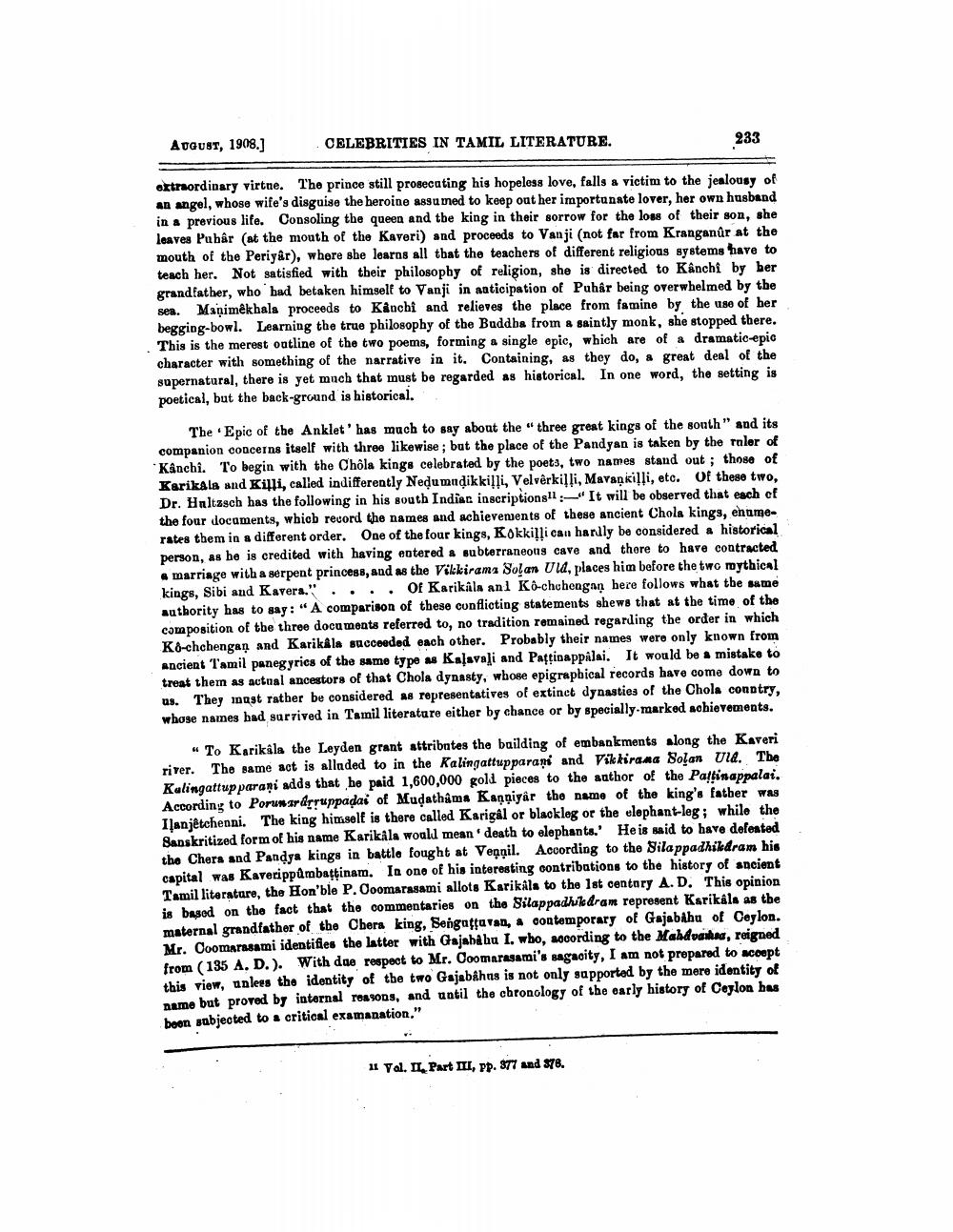________________
233
AUGUST, 1908.]
CELEBRITIES IN TAMIL LITERATURE.
extraordinary virtue. The prince still prosecuting his hopeless love, falls a victim to the jealousy of an angel, whose wife's disguise the heroine assumed to keep out her importunate lover, her own husband in a previous life. Consoling the queen and the king in their sorrow for the loss of their son, she leaves Puhâr (at the mouth of the Kaveri) and proceeds to Vanji (not far from Kranganûr at the mouth of the Periyâr), where she learns all that the teachers of different religious systems have to teach her. Not satisfied with their philosophy of religion, she is directed to Kânchi by her grandfather, who had betaken himself to Vanji in anticipation of Puhâr being overwhelmed by the sea. Manimêkhala proceeds to Kanchi and relieves the place from famine by the use of her begging-bowl. Learning the true philosophy of the Buddha from a saintly monk, she stopped there. This is the merest outline of the two poems, forming a single epic, which are of a dramatic-epic character with something of the narrative in it. Containing, as they do, a great deal of the supernatural, there is yet much that must be regarded as historical. In one word, the setting is poetical, but the back-ground is historical.
The Epic of the Anklet' has much to say about the "three great kings of the south" and its companion concerns itself with three likewise; but the place of the Pandyan is taken by the ruler of Kanchi. To begin with the Chôla kings celebrated by the poets, two names stand out; those of Karikala and Killi, called indifferently Nedumudikkilli, Velverkilli, Mavankilli, etc. Of these two, Dr. Haltzsch has the following in his south Indian inscriptions:-" It will be observed that each of the four documents, which record the names and achievements of these ancient Chola kings, enumerates them in a different order. One of the four kings, Kokkilli can hardly be considered a historical person, as he is credited with having entered a subterraneous cave and there to have contracted a marriage with a serpent princess, and as the Vikkirama Solan Uld, places him before the two mythical kings, Sibi and Kavera." .. Of Karikala an1 Kô-chchengan here follows what the same authority has to say: "A comparison of these conflicting statements shews that at the time of the composition of the three documents referred to, no tradition remained regarding the order in which Kô-chchengan and Karikala succeeded each other. Probably their names were only known from ancient Tamil panegyrics of the same type as Kalavali and Pattinappalai. It would be a mistake to treat them as actual ancestors of that Chola dynasty, whose epigraphical records have come down to us. They must rather be considered as representatives of extinct dynasties of the Chola country, whose names had survived in Tamil literature either by chance or by specially-marked achievements.
"To Karikala the Leyden grant attributes the building of embankments along the Kaveri river. The same act is alluded to in the Kalingattupparani and Vikkirana Solan Ula. The Kalingattup parani adds that he paid 1,600,000 gold pieces to the author of the Pattinappalai. According to Porunarárruppadai of Mudathâma Kanniyâr the name of the king's father was Ilanjêtchenni. The king himself is there called Karigâl or blackleg or the elephant-leg; while the Sanskritized form of his name Karikåla would mean ' death to elephants.' He is said to have defeated the Chera and Pandya kings in battle fought at Vennil. According to the Silappadhikaram his capital was Kaverippambaṭṭinam. In one of his interesting contributions to the history of ancient Tamil literature, the Hon'ble P. Coomarasami allots Karikala to the 1st century A. D. This opinion is based on the fact that the commentaries on the Silappadhikaram represent Karikala as the maternal grandfather of the Chera king, Seigaṭṭuvan, a contemporary of Gajabahu of Ceylon. Mr. Coomarasami identifies the latter with Gajabahu I. who, according to the Mahdvaikea, reigned from (135 A. D.). With due respect to Mr. Coomarasami's sagacity, I am not prepared to accept this view, unless the identity of the two Gajabâhns is not only supported by the mere identity of name but proved by internal reasons, and until the chronology of the early history of Ceylon has been subjected to a critical examanation."
11 Vol. II, Part III, pp. 377 and S76.




